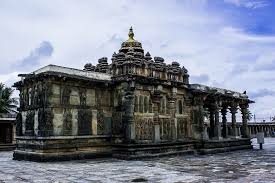There are many ancient temples with amazing architecture and historical places that reflect the Indian culture across the country. UNESCO recognizes some of them as 'World Heritage' to be preserved for future generations. Rabindra's Santiniketan in Kolkata and the temples built by the Hoysala kings in Karnataka have joined the list this year..!
The temples of the Hoysala kings built with a different Kannada style of architecture attract historians, tourists and art lovers even today. Among them, Belur - Chennakesava, Halebidu - Hoyasaleswara, Somanadhapura - Keshavalaya, which are known for their sculptures, have been recognized by UNESCO as heritage assets. Hoysala kings in AD They ruled the Kannada and Tamil regions for more than three centuries between the 11th and 14th centuries. Jainism, Buddhism and Hinduism were equally supported. More than 1500 temples were built with a blend of Dravidian, Vesara and Nagara styles. That's a soft soapstone art on high ridges
Chennakesava Temple:
Victory over the Cholas.. A famous Vaishnava temple built on the banks of Yagachi river by King Vishnuvardhana to mark Niki. He was born in AD. It was started in 1117 and took 103 years to complete. In this star- shaped temple, Moolavirattu is Vishnumurthy. Except for four pillars in the main temple, each one has unique carvings. Sculptures on the walls, jewelery and clothes represent the period. The sculptures of Salabhanjikas, the dancers of Yakshagathas, are irresistible. Ballini in a salabhanjika sculpture, and the close- by Egasi carving on a fruit shows the meticulous attention of the sculptors of the Vainam period. the mirror Sundari Sculpture- Said to be Vishnuvardhan's queen Shantha Ladevi. Despite being damaged many times in wars and rebuilt again and again, it is a wonderful testimony to the cultural and artistic outlook of that time!
Hoysaleswara Temple:
This is the largest Shiva temple which is divided into two shrines. Hoysaleswara and Shantaleswara lingas have been enshrined in these twin temples. Ramayana, Mahabharata and Bhagavata epic themes are beautifully carved in the form of Shiva on the walls. Although the artefacts in the temple have suffered a bit of damage, they are still intact. This was done by Keta, an official during the time of Vishnuvardhanaraja Malla seems to have been built in 1121.
Keshavalayam:
Janardana, Kesava, It is known that the temple of Trikuta, built on the banks of the Kaveri in the form of Venugopala, was built by Somanatha Dandanayaku during the reign of King Narasimha III and the lord was consecrated in 1268. The idol of Kesava was destroyed, the idols of Janardana and Venugopal were damaged. It also stands as an intact testimony of Hoysala architecture.
Santiniketan:
Santiniketan is bustling with buildings built in the midst of green trees, manicured gardens, students, teachers, writers and artists from abroad. Rabindra was a famous poet and philosopher Gurukula School, established in 1901 in Birbum district of West Bengal, is a cultural center. In 1921, 'Vishwa Bharati' University was established in this premises as a symbol of the fact that all human beings are one, erasing the boundaries of religions and cultures. The architecture of the British rule and the modern sensibilities of the Europeans contrasted with the folk traditions of the ancient and medieval times, a rare step towards Pan- Asia. Some buildings with mud walls and thatched roofs are still intact. Classes are still held in the shade of trees.. That's why this rare school has been selected as a UNESCO heritage. There is no doubt that Santiniketan and Hoysala temples under the care of 'Archaeological Survey of India' will attract more tourists with this recognition.




No comments:
Post a Comment